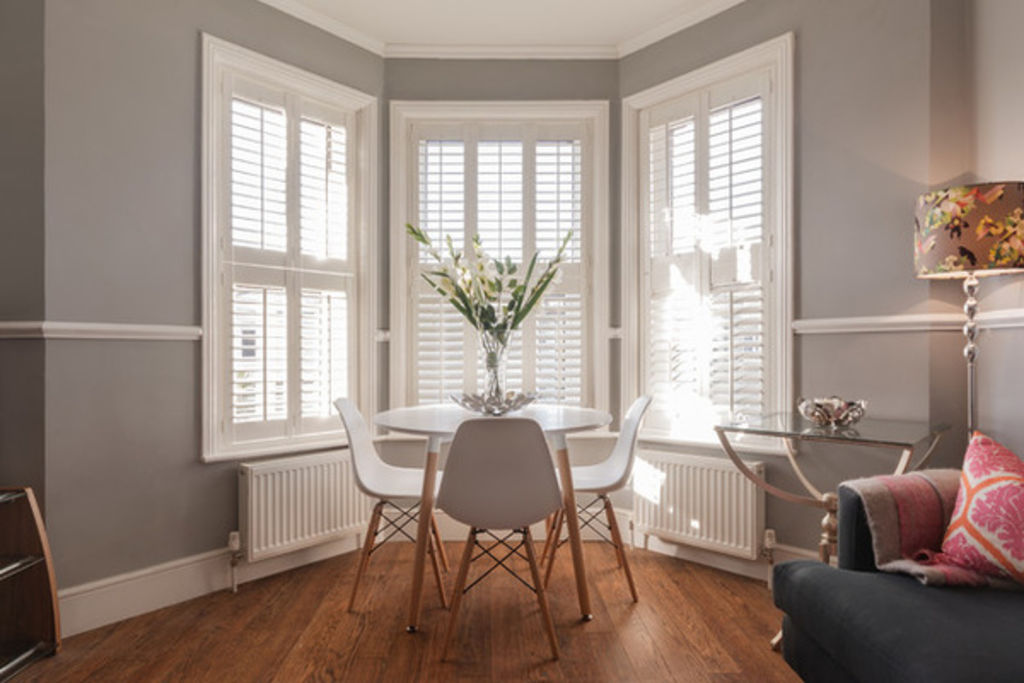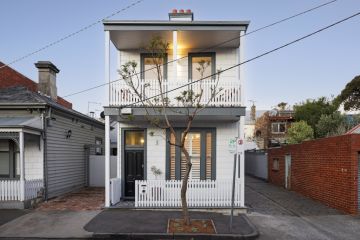Is your stuff making you unhappy?

Dining Room by Coral Interiors
Photo: Chris Baker, Planning 3D
Author: Leonora Sartori
We have taken the advice of decluttering gurus from Spain to the UK, who share their tricks to not only free up some space in your wardrobe, but create some free time in your busy life by keeping strict edits, sticking to things you use often and considering external storage.
Many of us dream of a perfect home, an immaculate and serene space with no fingerprints in the kitchen or dust on the shelves, a large walk-in wardrobe, and the books sorted by colour in the library. But in reality, many of us find ourselves with a too-small home full of old toys, too many shoes and books and paperwork everywhere.
The number of things in our home increases as time passes, while, unless we move house or renovate, the space remains the same. So what to do? Toss everything out without looking back, change apartments every seven years, sell everything on eBay, or accept chaos with stoic ease? Should we stick to the hard and fast rule of “One thing in, one thing out”, or follow themore laissez-faire motto “Life’s too short to declutter”?

The Experts and Their Solutions
So what’s the best way to deal with our clutter issues? Below, professional home organisers and declutterers from around the world tell their stories, before tackling common decluttering dilemmas.
Championing minimalism in Japan
Fumio Sasaki runs the blog Minimal & ism and wrote the popular book, We Do Not Need Things Any More, in which he describes how he became a minimalist. His version is rather extreme, with a very short list of necessary items he lets into his life and home, but has proved a success among Japanese readers in the generation now hitting their 30s.
“I think many people have learned that gathering things does not make you happy. The older generation (over 40s) experienced the bubble economy, which praised material abundance, but our generation didn’t. You can feel more liberated by having fewer things around you. Japan is an earthquake-prone country, but if an earthquake hits, I can run away with all of my belongings, which can easily be piled into a small case.”
Fumio Sasaki became a minimalist in 2013. “I happened to Google the term ‘minimalist’ in Japanese, and learned about Andrew Hyde, a famous minimalist blogger who lives with just 15 items. In retrospect, I was frustrated with my life and wanted to change it. It was almost a sudden enlightenment.”

Promoting practical beauty in Sweden
Paulina Draganja is Sweden’s unchallenged queen of organisation, with a popular blog, TV performances, lectures and a new book coming out on how to declutter and stay on top of stuff in the home.
Draganja believes the Swedes are a very practical people, which you can see in everything from cooking to fashion and design. “We want things to look good, but still be easy to maintain, to suit a lifestyle where both parties in a relationship go out to work. So no complicated, pedantic solutions, but smart and simple systems, and with a pared-back look,” she says.
“The hallway seems to be a recurring challenge in Sweden,” she adds. “Clothes are the trickiest things to store, especially as we have cold winters and a lot of bulky clothes.”
Helping people let go in Spain
Maria Gallay is a personal organiser who has been running her company, Organización del Orden, for 15 years. She says the Spanish tend to hang on to memorabilia, old books and photos, and that the minimalist thinking has not yet hit the nation.
“In Spain, most of the old stuff remains in houses forever, even if people live in small apartments. Clothing is the only thing we get rid of, when closets are too full. We don’t have a wide second-hand market in Spain. There’s no culture of swapping or garage sales, although many of my clients tell me they would like to do it.”
The sense of family is strong in both Spain and Italy, and people get deeply attached to things and find it hard to get rid of them. “I know Spanish parents who keep everything, even if their children are not interested in those objects from the past. Many keep bed linen, curtains, lamps, beds and other furniture, in case ‘the children’ need them in their future own home,” says Gallay.

Tackling paperwork in France
Pauline Levasseur has been a home organiser for six years in France. She created her own method and trains other pros.
“France has a very specific issue: the incredible volume of paperwork people have. French homeowners, who are called ‘paper kings’, receive a huge volume of administrative paperwork (a record in Europe!) and they have to keep them. So paper is one of the prime sources of clutter,” she says.
Take inspiration from these home offices
She believes clutter is more often than not linked to life issues (illness, divorce, death, etc). When a life-changing event happens, homeowners don’t take the time to declutter and think they will “do it later”, but then find themselves snowed under. They often call a home organiser when time has passed since the event and they decide it’s time to clean up the house and make a new start.
“French people struggle to throw things away; they are stuck in the ‘it-can-always-be-useful’ approach,” says Levasseur. “Also, the French are attached to souvenirs, and feelings are very important in the decision of whether to keep things or not.”

Your Decluttering Questions Answered
1. What’s your absolute top storage tip?
Paulina Draganja suggests,
“Everything in your home needs to have its own place, where it belongs. I try to stick to things I really like and use, and always ask myself where a new thing will be stored. If I can’t see the space in my mind, I often avoid buying the item.
“It’s best to focus on the things you already have and love,” continues Draganja, “and keeping them well stored is part of that process.”
In the Japanese My Houzz story A Timeless Primitive Beauty in Praise of Shadows, product designer Gwenael Nicolas, founder of design studio Curiosity, says, “When you design a house or apartment, remember to plan for 2.5 times more storage space than is sufficient for all the things you currently own.”
2. Is ruthless decluttering better than trying to make room for the old?
Daniela Mosca, owner of home organisation company Dani&Colf, teaches courses for families to help them organise household chores.
“From my point of view, it’s better to declutter ruthlessly,” she says. “That gives me the opportunity to invent new ways to combine things and play more fancifully, rather than have many things. I pay a lot of attention to functionality: It’s better to have a functional wardrobe than one that’s simply well organised with lots of boxes, containers and dividers, but that’s jam-packed with things.
“However, I don’t like the idea of a house run on warehousing rules (last in/first out or first in/first out),” she adds. “Rather, I think it’s important to teach children from an early age that everything has its own place, and that this facilitates their autonomy.”
Discover thousands of wardrobe storage ideas
3. How is order connected with our happiness?
“Happiness is not dependent on order,” says Australian organising guru MaryAnne Bennie, author of From Stuffed to Sorted and Paper Flow: Your Ultimate Guide to Making Paperwork Easy. “However, order brings with it a sense of calm and control and gives people more time to do things that make them happy.”
“Order also brings with it freedom to be, have and do whatever you like and you are more likely to be in the moment. By contrast, disorder (if perceived as a problem) keeps people stuck and unable to move forward (they put their present and future on hold while trying to sort our their past). Minimalism certainly lends itself to happiness potential.”
UK expert Helen Winter of Coral Interiors says, “The old adage ‘Tidy desk, tidy mind’ is completely correct. Not knowing where things are, or living in a dirty or chaotic environment, has a detrimental impact on our lives. We waste valuable mental energy when we live in a mess.”
4. How do we decide what to keep?
US writer Mindy Starns Clark,author of The House That Cleans Itself, says, “My technique for clearing clutter is based on the understanding that every possession you own, from the tiniest button to the biggest couch, consumes a piece of yourtime – time to clean it, store it, move it, fix it, lose it, find it, wash it, wipe it, and on and on. The more things we own, the more time we sacrifice to that ownership. Thus, when decluttering, ask yourself, ‘Is this item worth the total time investment that owning it requires?’ If it is, then keep it. If it isn’t, then get rid of it. It’s that simple – unless the item also carries an emotional component.”

5. Should the rule be: one thing in, one thing out?
“Sounds great if you’re the type of person who can remember to do it and force yourself to be timely about it,” says Mindy Starns Clark. “I think for more housekeeping-impaired types like me, it’s a habit that’s not likely to take hold. Better to schedule regular decluttering appointments with yourself – such as on the first day of each new season for a total of four times per year – and consistently declutter on those specified days.”
6. How do we get out of the chaos?
MaryAnne Bennie says we need to take the true test with all our objects. “Attachment is a very subjective thing, and when people claim to have a strong attachment to something they don’t use, the true test is whether they place it in a position of honour in their home. If it’s relegated to storage, often a photo of the item will suffice as a memory prompt and the item can be released to others,” she says.
“If the item is something to be passed on to the next generation, then suitable storage needs to be found. There’s been a huge increase in external storage rental and environmental removal services in Australia,” Bennie adds.
German decluttering expert Denise Colquhoun, also known as Fräulein Ordnung, wroteSeven Days for a Tidy Life (original German title: Sieben Tage für ein aufgeräumtes Leben: Das kreative Mitmach-Heft), and gives this tip. “Keep the floor tidy and put away everything lying on the ground at least once a day. Ask yourself: Laundry? Waste? Into the closet? Into another room? The box with decluttered clothes sitting in your corridor for months? Forget it! Donate it instead, and be happy about losing this burden.”
Interior designers help you get the most out of your space – fine one in your area
7. How much is too much?
Having clear and workable rules when it comes to how many things you should bring into your home seems to be a popular line of thought among both experts and Houzzers.
“I suggest implementing space limit rules,” says Mindy Starns Clark. “For example, tell yourself you can hang on to as many mementos as you like, but only up to the storage capacity of one curio cabinet. You can keep old letters and papers and kids’ artwork, but only up to the storage capacity of two large sealable bins. You can keep all the books you love, but only up to the storage capacity of three bookshelves.
“If you decide on a reasonable storage limit – don’t be unrealistically stingy, especially at first – and stick to that limit, then you’re only forced to purge when your quantity of items exceeds the designated space,” Clark adds.
“Why keep the sweatshirt I had when I was 15 or the pants from my first pregnancy?” says Italian organiser Daniela Mosca. “I understand that some items have an emotional bond, and that you might want to pass some things on to the children, but then I suggest you choose carefully, and set a numerical limit: a maximum of five pieces that you don’t wear anymore and that you care about only for sentimental reasons,”
When it comes to storage and what we need, there are no rules set in stone. “Each person or family needs to set their own limits on what’s right for them,” says MaryAnne Bennie. “They can limit by number (e.g., three towels per person plus two spares for guests) or by space available (e.g., one shelf is allocated to recipe books and once it’s filled, it’s one in, one out). Or they can limit by age (e.g., latest 12 months of a favourite magazine). As long as limits are set in every category, quantity issues cease to exist,” Bennie says.
Minimalist Fumio Sasaki has of course taken a rather tougher stance on what’s allowed in his home. His list is a wonder of restraint.
“Shoes: 5 pairs (sandals, white sneakers, rain boots, slip-on shoes, and black formal leather shoes.) Books: I don’t keep books at home. Well, I have only one paper book at a time, and I get rid of it as soon as I finish reading it. I enjoy using a Kindle. Before I became a minimalist, I had a lot of books I hadn’t read, and it made me feel guilty and unhappy. I don’t feel that way any more.
Kitchen: About 20 items.
T-shirts: 20.
Underwear and socks: 4 sets. Shirts: 4.”
Follow Houzz Australia on Facebook
We recommend
States
Capital Cities
Capital Cities - Rentals
Popular Areas
Allhomes
More
- © 2025, CoStar Group Inc.







